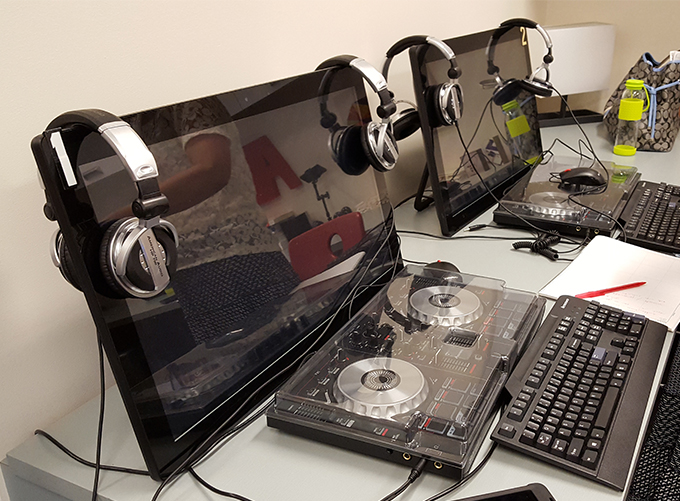Conference Maps Out Plan to Integrate Emerging Technology into Everyday Curriculum
Teachers, administrators, technology specialists and various other K–12 educators hailing from six different states descended upon Chicago’s Catherine Cook School June 20 to 22 for its Innovation, Design, Engineering, and Art: Transforming Education (IDEA:TE) conference.
While IDEATE was not solely created to coincide with the White House’s Week of Making, this conference of creativity gave educators hands-on training with not only some of the most popular emerging technologies, like 3D printers and Internet of Things (IoT) gizmos, but also with traditional crafts like sewing and woodworking.
In addition to providing first-hand experiences with university-level technologies, JD Pirtle and Stacy Shafer Peterson, IDEATE’s creators, wanted teachers to walk away with practical and replicable examples of dynamic and engaging curricula for using those tools.
And Catherine Cook is the perfect school to emulate such concepts. Peterson has been the school’s director of advancement since 2011, and in 2013, the school hired Pirtle as the director of innovation; he covers everything that is not traditional Edtech or IT. In other words, Pirtle neither teaches kids how to blog, nor does he troubleshoot the network servers (even though he knows how to). He was, however, influential in the academy’s decision to transform its library into an IDEA lab, or maker space. There, students as young as age 3 can tinker with things like sewing machines, robotics, laser cutters or Google Cardboard.
“The domains I cover in our IDEA program are innovation, design, engineering and art,” says Pirtle, who has has worked with virtual reality at the University of Illinois at Chicago’s Electronic Visualization Laboratory. “That includes robotics, carpentry, textile arts, programming, electronics, digital fabrication, and rapid prototyping. In other words, creative tech — everything that goes beyond traditional edtech, which includes blogging and digital portfolios.”
Tech Tools of the Trade
Every tool that Catherine Cook uses to conduct normal, day-to-day learning was used by participants at the IDEA:TE conference. For example, each attendee in a MinecraftEdu workshop hopped on a Lenovo ThinkPad Yoga to construct buildings from the 1893 World’s Columbian Exposition in Chicago. The attendees also recreated Cook students’ social studies projects exploring ancient civilizations in MinecraftEdu’s “The Wonderful World of Humanities.”
“I love the concept. I think with a little bit of tweaking I can definitely integrate it into the classroom curriculum,” says attendee Lindsay Mosshammer, a second- and third-grade science teacher at Frances Xavier Warde School in Chicago. “One of our units focused on habitats meeting the needs of different creatures. We’ve been trying to figure out how to use technology authentically in this lesson. I want to move away from giving a kid a shoebox to make a diorama. MinecraftEdu is an interesting, playful way to create a world that showcases how they can meet the animal’s needs in a way that is playful and friendly for them.”
Instructor Dana Stewart explained to the teachers that, in order to implement the game successfully, they would need to have an IT person on staff who understands memory, bandwidth and LAN configuration. In addition, teachers have the ability to deploy MinecraftEdu worlds over Wi-Fi to notebooks from a dedicated desktop. Those worlds then act as the server, where projects can be saved. Unfortunately, Chromebooks cannot currently run MinecraftEdu software, but that could change as a result of its switch to the Microsoft ecosystem this school year.
Audiovisual Technologies Add Oomph
Even standard presentations were impressively upgraded at Catherine Cook. “Applying Computational Thinking Principles Through Activities and Play,” a slideshow presented by software engineers Kristin Kaeding of 8th Light Software and Don Schwarz of Google, were displayed on a wall of 12 Planar monitors (purchased through CDW) measuring 13 feet by 5 feet.
The building also houses a fully equipped audiovisual studio, where Brian Puerling, Catherine Cook’s director of education technology (and a former member of the Sesame Street Teacher Council), taught IDEA:TE attendees examples of AV technologies like stop motion video; apps like DJ Mix Kids; and software like Audacity, which teachers can use in developmentally appropriate ways to cultivate confidence, collaboration and communication skills. Puerling explained, for example, that kindergarteners can create videos and music to demonstrate what they’ve learned from a lesson. The AV studio was decked out with four double-turntable AV editing workstations, along with a separate green screen room. Puerling also instructed IDEA:TE educators on how to use QR codes to check equipment in and out.

Catherine Cook's AV equipment enables dynamic learning.
Storage and networking is becoming increasingly important as the school experiments more with 3D scanning and modeling software like Autodesk AutoCAD, and virtual reality (VR) projects that require a great deal of memory.
“VR is a logical next step for us,” says Pirtle, explaining why even grade-schoolers would need virtual reality. He says as the kids play with VR at home, they begin to expect it at school. A great application for VR in elementary school is to take students to places that are too expensive to visit, are not age-appropriate for preschoolers, are forbidden to tourists, or will no longer exist due to rising sea levels. Google and a host of other companies are taking scans and sound files of World Heritage sites in an effort to make more VR “destinations” available to curious schoolchildren.
In the future, officials at the Catherine Cook School are hoping to one day do their own scans by attaching a tetrahedral surround camera to one of the school’s drones to scan 2D and 3D video from above; for now, however, the VR content that Cook produces is not too large. On the other hand, the video projects from Cook’s AV studio often generate terabytes of data, and that has caused the school to shift to a cloud-based storage model, explains Pirtle. “We will be very particular about what we store on site. We have a gigabit connection between devices in the school so that we can move data pretty quickly. In addition, our IT director Nosson Cohen is building an experimental server on site for such projects.” Currently, teachers and students transfer data over Wi-Fi using Xirrus’s high performance enterprise-grade network.
“Our school is usually on the ground floor in tech. As far as converging tech in the classroom, we’re definitely at the bleeding edge in Chicago,” says Pirtle. His advice to schools looking to replicate Cook’s program? “Conducting a pilot with the stakeholders — students, teachers, and staff — is a great way to begin. But you want everything to be intentional. You don’t want to just throw tech at the kids or teach them to throw tech at their problems. You want technology to be a part of the curriculum. That is really important.”








